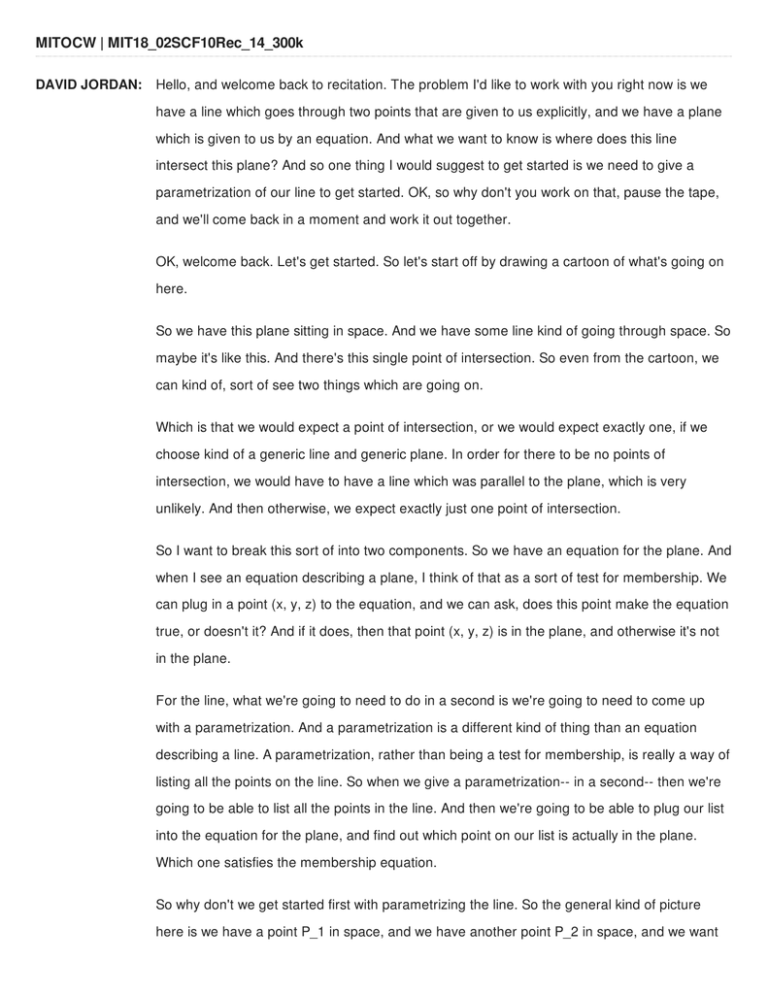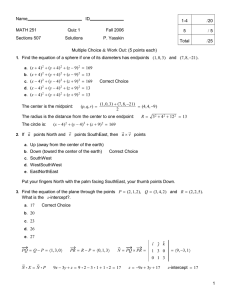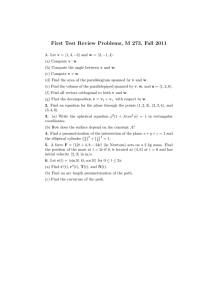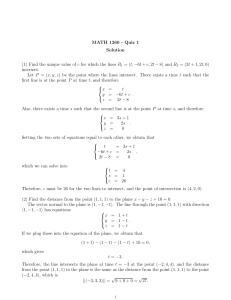MITOCW | MIT18_02SCF10Rec_14_300k
advertisement

MITOCW | MIT18_02SCF10Rec_14_300k DAVID JORDAN: Hello, and welcome back to recitation. The problem I'd like to work with you right now is we have a line which goes through two points that are given to us explicitly, and we have a plane which is given to us by an equation. And what we want to know is where does this line intersect this plane? And so one thing I would suggest to get started is we need to give a parametrization of our line to get started. OK, so why don't you work on that, pause the tape, and we'll come back in a moment and work it out together. OK, welcome back. Let's get started. So let's start off by drawing a cartoon of what's going on here. So we have this plane sitting in space. And we have some line kind of going through space. So maybe it's like this. And there's this single point of intersection. So even from the cartoon, we can kind of, sort of see two things which are going on. Which is that we would expect a point of intersection, or we would expect exactly one, if we choose kind of a generic line and generic plane. In order for there to be no points of intersection, we would have to have a line which was parallel to the plane, which is very unlikely. And then otherwise, we expect exactly just one point of intersection. So I want to break this sort of into two components. So we have an equation for the plane. And when I see an equation describing a plane, I think of that as a sort of test for membership. We can plug in a point (x, y, z) to the equation, and we can ask, does this point make the equation true, or doesn't it? And if it does, then that point (x, y, z) is in the plane, and otherwise it's not in the plane. For the line, what we're going to need to do in a second is we're going to need to come up with a parametrization. And a parametrization is a different kind of thing than an equation describing a line. A parametrization, rather than being a test for membership, is really a way of listing all the points on the line. So when we give a parametrization-- in a second-- then we're going to be able to list all the points in the line. And then we're going to be able to plug our list into the equation for the plane, and find out which point on our list is actually in the plane. Which one satisfies the membership equation. So why don't we get started first with parametrizing the line. So the general kind of picture here is we have a point P_1 in space, and we have another point P_2 in space, and we want to parametrize the line which goes between them. And there's actually a very simple way to do this. What we do is we want to take our original point P_1, and we want to add a variable t times the vector P_2 minus P_1 which connects them. So that's this one here. OK. So this is a reasonable thing to do, because if we plug in t equals 0, then we just get P_1. And if we plug in t equals 1, then we get P_1 plus P_2 minus P_1; we just get P_2. So this line definitely goes through those two points, and that's all that we really need. So in our specific problem here, we have-- P_1 we can take to be the first point, 0, minus 1, 1. And then we have t times-- so we have 2 minus 0 is 2-- 3 minus a negative 1 is 4-- and 3 minus 1 is 2. And this is the vector connecting those. And so we can write, we can just combine these two and we get 2t, 4t minus 1, and 2t plus 1. OK? So this here is a parametrization of the line. So as we vary t-- now, walking back over to our picture-- as we vary t, we're going to just be listing all the points on the line. And we're going to ask, for which point are we actually contained in the plane? So let's go over to the board over here and solve that. So what we want to know is does this point satisfy the equation for the plane? And our plane was given to us by the equation 2x plus y minus z equals 1. So x on our line is 2t. So we have 2 times 2t, plus-- y is 4t minus 1, minus-- z is 2t plus 1. And all this is meant to equal 1. OK. So if we expand this out, we get 4t plus another 4t minus 2t and we get minus 1 minus another 1-- so we get minus 2-- equals 1. So altogether we get 6t equals 3, so that tells us that t is 1/2. OK? And finally, to get our answer, we need to go back over to our parametrization of the line and plug in t equals 1/2. So coming back over here, plugging in t equals 1/2, we get 1-- 2 minus 1 is 1-- and 1 plus 1 is 2. OK, so we get the point of intersection, (1, 1, 2). So that was quite a few steps, so let's review what we did. So to begin with, we needed to understand that the equation for a plane is a test for membership. It's not a list of all the points in the plane, it's a test for membership. The parametrization of the line, on the other hand, is a way of listing all of the points on the line. And so if our goal is to find which particular point on the line is contained in the plane, then we need to parametrize our line, and then we need to plug in our parametrization to our equation for the plane, and then solve for the value of t which makes it true. Finding that t then we've-- that's is equivalent to finding a point on our line. And I think I'll leave it at that.





